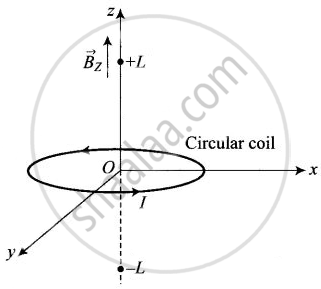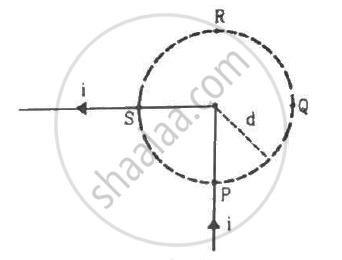Advertisements
Advertisements
प्रश्न
Consider a circular current-carrying loop of radius R in the x-y plane with centre at origin. Consider the line intergral
`ℑ(L ) = |int_(-L)^L B.dl|` taken along z-axis.
- Show that ℑ(L) monotonically increases with L.
- Use an appropriate Amperian loop to show that ℑ(∞) = µ0I, where I is the current in the wire.
- Verify directly the above result.
- Suppose we replace the circular coil by a square coil of sides R carrying the same current I. What can you say about ℑ(L) and ℑ(∞)?
उत्तर
Magnetic field due to a circular current-carrying loop lying in the xy-plane acts along z-axis as shown in figure.
a. B(z) points in the same direction of z-axis and hence ℑ(L) is monotonical function of L as B and dl are long in the same direction.
So B.dl = Bdl cos θ = Bdl cos θ° = Bdl
∴ ℑ(L) is monotonically increasing function of L.
b. Now consider as Amperean loop around the circular coil of such a large radius that L → `oo`. Since this loop encloses a current I, Now using Ampere's law
`ℑ(oo) = oint_(-oo)^(+oo) vec(B) * vec(dl) = mu_0I`
c. The magnetic field at the axis (z-axis) of circular coil is given by `B_z = (mu_0IR^2)/(2(z^2 + R^2)^(3/2)`
Now integrating
`int_(-oo)^(+oo) B_z dz = int_(-oo)^(+oo) (mu_0IR^2)/(2(z^2 + R^2)^(3/2)) dz`
Let z = R tan θ so that dz = R sec2 θ dθ
And `(z^2 + R^2)^(3/2) = (R^2 tan^2 theta + R^2)^(3/2)`
= `R^3 sec^3θ (as 1 + tan^2θ = sec^2θ)`
Thus `int_(-oo)^(+oo) B_zdz = (mu_0I)/2 int_(- pi/2)^(+ pi/2) (R^2(R sec^2 θ dθ))/(R^3 sec^3θ)`
= `(mu_0I)/2 int_(- pi/2)^(+ pi/2) cos θ dθ = mu_0I`

d. As we know `(B_z)_("square") < (B_z)_("circular coil")`
For the same current and side of the square equal to radius of the coil
`ℑ(oo)_("square") < ℑ(oo)_("circular coil")`
By using the same argument as we done in case (b), it can be shown that `ℑ(oo)_("square") < ℑ(oo)_("circular coil")`
APPEARS IN
संबंधित प्रश्न
At a place, the horizontal component of earth's magnetic field is B and angle of dip is 60°. What is the value of horizontal component of the earth's magnetic field at equator?
Figure shows a long wire bent at the middle to form a right angle. Show that the magnitudes of the magnetic fields at the point P, Q, R and S are equal and find this magnitude.

Two circular coils of radii 5.0 cm and 10 cm carry equal currents of 2.0 A. The coils have 50 and 100 turns respectively and are placed in such a way that their planes as well as the centres coincide. If the outer coil is rotated through 90° about a diameter, Find the magnitude of the magnetic field B at the common centre of the coils if the currents in the coils are (a) in the same sense (b) in the opposite sense.
A circular loop of radius 20 cm carries a current of 10 A. An electron crosses the plane of the loop with a speed of 2.0 × 106 m s−1. The direction of motion makes an angle of 30° with the axis of the circle and passes through its centre. Find the magnitude of the magnetic force on the electron at the instant it crosses the plane.
A circular coil of 200 turns has a radius of 10 cm and carries a current of 2.0 A. (a) Find the magnitude of the magnetic field \[\vec{B}\] at the centre of the coil. (b) At what distance from the centre along the axis of the coil will the field B drop to half its value at the centre?
A circular loop of radius 4.0 cm is placed in a horizontal plane and carries an electric current of 5.0 A in the clockwise direction as seen from above. Find the magnetic field (a) at a point 3.0 cm above the centre of the loop (b) at a point 3.0 cm below the centre of the loop.
Which of these equations is the correct expression for force on a charge in magnetic field?
The magnitude of the magnetic field due to a circular coil of radius R carrying a current I at an axial distance x from the centre is ______.
The magnetic field at a distance r from a long wire carrying current I is 0.4 tesla. The magnetic field at a distance 2 r is ______.
If we double the radius of a coil keeping the current through it unchanged, then the magnetic field at any point at a large distance from the centre becomes approximately.
